
Project Gutenberg's Economy of the Round Dairy Barn, by Wilber John Fraser This eBook is for the use of anyone anywhere at no cost and with almost no restrictions whatsoever. You may copy it, give it away or re-use it under the terms of the Project Gutenberg License included with this eBook or online at www.gutenberg.org Title: Economy of the Round Dairy Barn Author: Wilber John Fraser Release Date: December 16, 2011 [EBook #38321] Language: English Character set encoding: ISO-8859-1 *** START OF THIS PROJECT GUTENBERG EBOOK ECONOMY OF THE ROUND DAIRY BARN *** Produced by Bryan Ness, Pat McCoy and the Online Distributed Proofreading Team at http://www.pgdp.net (This file was produced from images generously made available by The Internet Archive/American Libraries.)
UNIVERSITY OF ILLINOIS
Agricultural Experiment Station
BULLETIN NO. 143
By WILBER J. FRASER

URBANA, ILLINOIS, FEBRUARY, 1910
[Pg 1]
Full Specifications and Detailed Cost and Construction of the New Sixty-foot Circular Dairy Barn at the University. Saving of Round over Rectangular Barns. Notes on Several Round Barns on Dairy Farms.[A]
By W. J. FRASER, Chief in Dairy Husbandry
The planning, construction, and arrangement of farm buildings do not usually receive the thought and study these subjects warrant. How many dairymen have compared a circular, 40-cow barn with the common rectangular building containing the same area? How many understand that the circular structure is much the stronger; that the rectangular form requires 22 percent more wall and foundation to enclose the same space; and that the cost of material is from 34 to 58 percent more for the rectangular building?
In a community in which everyone is engaged in the same occupation, one person is likely to copy from his neighbor without apparently giving a thought as to whether or not there is a better way.
In a district of Kane county, Illinois, a certain type of dairy barn is used by nearly everyone, while in the next county a distinctly different type prevails, and the dairy barns of another adjacent county differ from those of either of the former, simply because the early settlers of this particular locality came from an eastern state and started building the style of barn then common in Pennsylvania.
In a certain community in Ohio where a milk condensing factory is located, a large number of farmers have barns 36 × 60 feet, with an “L” the same size. The loft of the “L” is used for the storage of straw, and the cows run loose in the lower portion. These barns are all built on practically the same plan and are usually of the same size, and this is the only community known to the writer where this form of barn is used in this manner.
This tendency to imitate emphasizes the fact that men do not exercise sufficient originality. Because most barns are rectangular is no reason that this is the best and most economical form.
[A] Special acknowledgment is made to Mr. H. E. Crouch and Mr. R. E. Brand for their assistance in working out the detailed data which are the bases for the economic comparisons of the round and rectangular barns made in this bulletin.
[Pg 2]
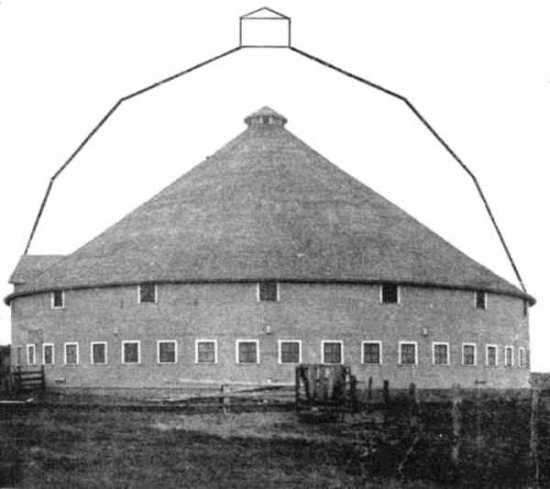 Fig. 1. Barn No. 5. 100 feet in diameter, scale 20 feet to one inch; Showing
increased mow capacity given by self-supporting roof.
Fig. 1. Barn No. 5. 100 feet in diameter, scale 20 feet to one inch; Showing
increased mow capacity given by self-supporting roof.
In an early day when lumber was cheap, buildings were built of logs, or at least had heavy frames. Under these conditions, the rectangular barn was the one naturally used, and people have followed in the footsteps of their forefathers in continuing this form of barn. The result is that the economy and advantages of the round barn have apparently never been considered. This is because they are not obvious at first sight, and become fully apparent only after a detailed study of the construction. For these reasons, the rectangular form still continues to be built, altho it re[Pg 3]quires much more lumber. As the price of lumber has advanced so materially in recent years, the possible saving in this material is a large item, and well worth investigating.
The objections to round barns have usually been made by those who have only a superficial knowledge of the subject, and do not really understand the relative merits of the two forms. To the writer's knowledge, there has never been published a carefully figured out, detailed comparison of a properly constructed circular barn with the rectangular barn.
The difficulty with most round barns that have been built, thus far, is that they do not have a self-supporting roof, and consequently lose many of the advantages of a properly constructed round barn. This is the principal reason why round barns have not become more popular. A straight roof necessarily requires many supports in the barn below. These are both costly and inconvenient, and make the roof no stronger than a dome-shaped, self-supporting roof which nearly doubles the capacity of the mow. See Fig. (1).
Many who have thus disregarded capacity have also wasted lumber and made a needless amount of work by chopping or hewing out the sill and plate, thus requiring more labor and lumber, besides sacrificing the greater strength of a built-up sill. Rightly constructed round barns are, however, being built to a limited extent. One contractor has erected twenty-four round barns, with self-supporting roofs, in the last nine years. These barns vary in size from 40 feet in diameter with 18-foot posts to 102 feet in diameter with 30-foot posts.
Another reason for the scarcity of round barns is the difficulty in getting them built. Most carpenters hesitate to undertake the work because in the erection of a round barn the construction should be entirely different from that of the rectangular form. Many new problems present themselves, but when these are once understood, the round barn offers no more difficulties in construction than the rectangular form. It is, however, important to have a head carpenter who is accustomed to putting up round barns, as a man with ingenuity and experience can take advantage of many opportunities to save labor and material.
The first thing to consider in the erection of a barn is a convenient arrangement for the purpose for which it is to be used. At the University of Illinois, two years ago, a twenty-acre demonstration dairy farm was started, the sole object being to produce the largest amount of milk per acre at the least possible cost. To[Pg 4] meet the requirements of a barn for this purpose, it became imperative to build one that was convenient for feeding and caring for the cows, economical of construction, and containing a large storage capacity in both silo and mow. These are the requirements of a barn for every practical dairyman.
 Fig. 2. Filling the silo.
Fig. 2. Filling the silo.
A silo was needed that could be fed from the year round. With the small number of cows kept, a deep enough layer of silage could not be fed off each day to keep it good thru the summer, if the silo was more than 12 feet in diameter. As this small diameter was a necessity, it would require two silos 33 feet deep to supply enough silage. Two silos of such small diameter would not only be costly, but difficult to make stand, unless built of concrete. This difficulty was overcome by using the circular barn and placing in the center a silo which is 12 feet in diameter and 54 feet deep, thus making the one silo, with as much capacity as the two before mentioned, answer every purpose. This deep silo is an important part of the round barn, as it not only forms a support for the roof, but is protected by the barn, thus saving the cost of siding. Then, too, besides occupying the space least valuable for other purposes, it being centrally located, is in the most convenient place for feeding. The silage chute being open at the top forms a suction of air, which keeps the silage odor from the barn at milking time, and also assists in ventilation when the door to the chute is open.
[Pg 5]
The points of superiority that the round dairy barn shows over the rectangular form are convenience, strength, and cheapness.
Considering that the barn on a dairy farm is used twice every day in the year, and that for six months each year the cows occupy it almost continuously, and that during this time a large amount of the labor of the farm is done inside the barn, it is evident that the question of its convenience is a vital one. The amount of time and strength wasted in useless labor in poorly arranged buildings is appalling. People do not stop to consider the saving in a year or a lifetime by having the barn so conveniently arranged that there is a saving of only a few seconds on each task that has to be done two or three times every day.
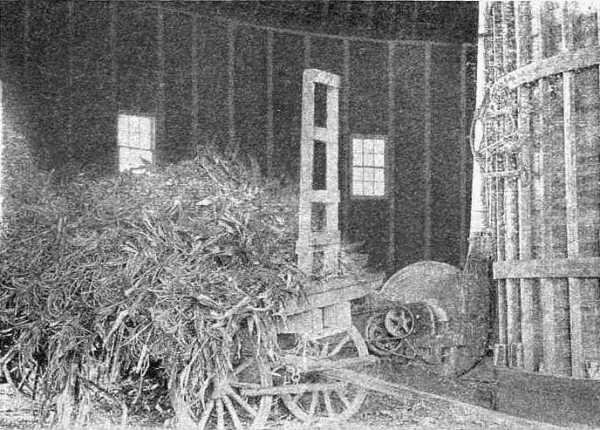 Fig. 3. Interior of barn, second floor, showing silo and location
of ensilage cutter. (team unhitched to show cutter.)
Fig. 3. Interior of barn, second floor, showing silo and location
of ensilage cutter. (team unhitched to show cutter.)
The round barn has a special advantage in the work of distributing silage to the cows. The feeding commences at the chute where it is thrown down, and is continued around the circle, ending with the silage cart at the chute again, ready for the next feeding. The same thing is true in feeding hay and grain.
[Pg 6]Still another great advantage is the large unobstructed hay mow. With the self-supporting roof, there are no timbers whatever obstructing the mow, which means no dragging of hay around posts or over girders. The hay carrier runs on a circular track around the mow, midway between the silo and the outside wall, and drops the hay at any desired point, thus in no case does the hay have to be moved but a few feet, which means a saving of much labor in the mowing.
To successfully embody all of the above discussed advantages in a dairy barn is one of the large problems in milk production. In a careful study of the barn question it soon became apparent that it was impossible to embody all of the requirements advantageously in anything but a circular form of building, and the 60-foot round barn, which is here described, was built.
The circular construction is the strongest, because it takes advantage of the lineal, instead of the breaking strength of the lumber. Each row of boards running around the barn forms a hoop that holds the barn together. A barrel, properly hooped and headed, is almost indestructible, and much stronger than a box, altho the hoops are small. This strength is because the stress comes on the hoops in a lineal direction. Any piece of timber is many times stronger on a lineal pull than on a breaking stress. Take for example a No. 1 yellow pine 2 × 6, 16 feet long, with an[Pg 7] actual cross section of 15⁄8 × 55⁄8 inches. If placed on edge and supported at the ends, as a joist, the limit of safety for a load evenly distributed is 642 pounds, while the limit of safety for a load in the lineal direction of the same piece of timber is 12,800 pounds, or twenty times as great.
 Fig. 5. In cow stable, showing silo and feed alley in center of
barn; Stanchions on right, milk scales and record sheet on left.
Fig. 5. In cow stable, showing silo and feed alley in center of
barn; Stanchions on right, milk scales and record sheet on left.
All exposed surfaces of a round barn are circular, as both the sides and roof are arched, which is the strongest form of construction to resist wind pressure; besides, the wind, in striking it, glances off and can get no direct hold on the walls or roof, as it can on the flat sides or gable ends of a rectangular structure. If the lumber is properly placed in a round barn, much of it will perform two or more functions. Every row of siding boards running around the building serves also as a brace, and the same is true of the roof boards and the arched rafters. If the siding is put on vertically and the roof built dome-shaped, no scaffolding is required inside or out. These are points of economy in the round construction.
In order to compare the amount and cost of material in round and rectangular barns, the following figures have been carefully worked out by an expert barn builder. Two comparisons, based[Pg 8] on wood construction thruout, are made, in which round barns 60 feet and 90 feet in diameter are compared with both plank and mortise frame rectangular barns containing the same number of square feet of floor space, respectively. Since the most practical width of a rectangular dairy barn is 36 feet, its length will depend upon the number of square feet required in the barn.
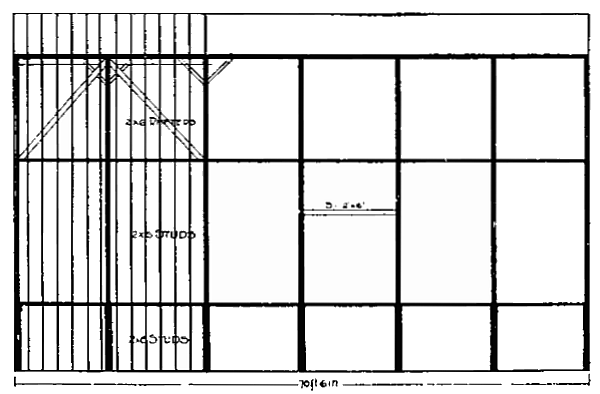 Fig. 7. Showing construction of plank frame barn, side view.
Fig. 7. Showing construction of plank frame barn, side view.
Figures 6 to 9 are side and end views, showing the detail construction and size of the timbers of the plank frame and mortise frame barns here figured. The detailed figures of the lumber bills for each of these barns were carefully worked out, but are too voluminous for publication here. The total number of feet of each kind of lumber required is given in Tables 1A and 1B. Since the proportion of the different kinds of lumber and shingles varied for the different barns, to draw an exact comparison it was[Pg 9] necessary to base it upon the money value, and for this purpose the total cost of lumber has been figured in each case. The lumber values used thruout are the best average prices that could be obtained. As the same prices are used for the material of all the barns, the comparisons of cost are correct, altho these exact prices will not hold for all localities and all times.
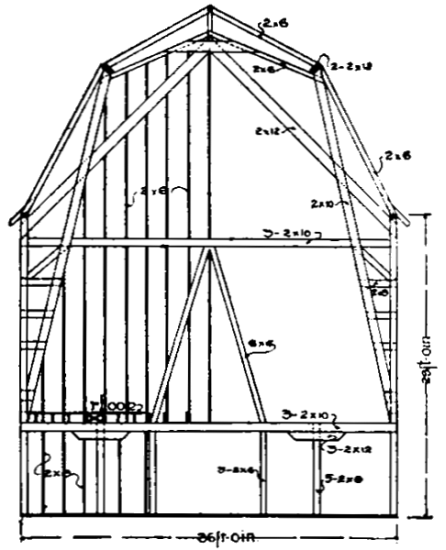 Fig. 8. Showing construction of
plank frame barn, end view.
Fig. 8. Showing construction of
plank frame barn, end view.
Since a silo cannot be economically built inside of a rectangular barn, the first comparison is made with the barns simply enclosed, altho one of the chief advantages of a round barn is the deep silo which it is possible to build so economically in the center.
Another item of economy in the circular barn is less framing lumber. This form has the strongest possible construction with the least lumber in the frame, and the least bracing, not a single[Pg 11] timber larger than a 2 × 6 being required above the sill. The arched circular roof requires no supports, and no scaffolding is needed inside during its construction.
The accompanying tables show the comparative amount and value of lumber and cubical content in round barns 60 and 90 feet in diameter, and rectangular barns of equal area and height of posts.
Table 1A.—A Comparison of the Cost of Material in Round and Rectangular Barns of the Same Area, Not Including Foundation and Silos
| Rectangular barn, 36 × 781⁄2 ft. | |||
| Round Barn 60 feet in diameter | Plank frame | Mortise frame | |
| Framing lumber | 13,976 ft. @ $25 = $349.40 | 19,833 ft. @ $25 = $495.83 | 29,074 ft. @ $25 = $726.85 |
| Sheathing, siding, and flooring | 12,971 ft. @ $22 = 285.36 | 15,355 ft. @ $22 = 337.81 | 15,355 ft. @ $22 = 337.81 |
| Shingles | 44,000 @ $3.75 = 165.00 | 45,000 @ $3.75 = 168.75 | 45,000 @ $3.75 = 168.75 |
| Bolts | 20.88 | ||
| Total cost of lumber | $799.76 | $1023.27 | $1233.41 |
| Content, cubic feet | 117,669 | 117,138 | 117,138 |
| Rectangular barn, 36 × 1763⁄4 ft. | |||
| Round barn, 90 feet in diameter | Plank frame | Mortise frame | |
| Framing lumber | 30,899 ft. @ $25 = $772.48 | 38,815 ft. @ $25 = $970.38 | 59,481 ft. @ $25 = $1487.03 |
| Sheathing, siding, and flooring | 22,375 ft. @ $22 = 492.25 | 28,547 ft. @ $22 = 628.03 | 28,547 ft. @ $22 = 628.03 |
| Shingles | 97,000 @ $3.75 = 363.75 | 102,000 @ $3.75 = 382.50 | 102,000 @ $3.75 = 382.50 |
| Bolts | 26.76 | ||
| Total cost of lumber | $1628.48 | $2007.67 | $2497.56 |
| Content, cubic feet | 322,952 | 270,570 | 270,570 |
In comparing the 60-foot round barn with a rectangular barn of the same area, the two barns should afford the cows the same amount of space on the platform. Allowing each cow in the 60-foot round barn 3 feet 6 inches in width at the rear of the platform, it will accommodate 40 cows and leave space for two passage ways. But in a rectangular barn, only 3 feet 4 inches of platform space need be allowed for each cow, and the 781⁄2 foot barn, with two 3-foot passage ways across it for convenience in feeding, will accommodate 42 cows. While the rectangular barn has stall room for two more cows, the round barn contains space in the center for a silo 18 feet in diameter.
The floor space and cubical content of the round barn 60 feet in diameter, and the rectangular barn compared with it in these tables, are practically the same, and the barns are therefore directly comparable. This being true, the percentages which were figured from the complete bills of material for these barns show the exact saving in lumber on the 60-foot round barn over the plank and mortise frame rectangular barns 36 × 781⁄2 feet. The lumber bills of the rectangular barns show an increase in cost of 28 percent for the plank frame and 54 percent for the mortise frame. The round barn, 60 feet in diameter, contains 1881⁄2, and the rectangular barn 225 lineal feet of wall. The rectangular barn has, therefore, 22 percent more lineal feet of outside barn wall, requiring a proportional increase in both paint and foundation.
The 1763⁄4-foot rectangular barn would hold 100 cows, allowing each cow 3 feet 4 inches in width and providing for 3 passage ways of 3 feet each across the barn.
The 90-foot round barn would hold 100 cows in two rows
headed together, 65 of which would be in the outer circle, and have
3 feet 6 inches each in width at the gutter. This leaves sufficient
room for feed alleys and walks, and two passage ways, one three
feet and the other seven feet wide for the manure and feed carriers.
All of this is outside of a central space for a silo 20 feet
in diameter and 71 feet high, with a capacity for 620 tons of silage,
and in the mow there would still be an excess, above the capacity
of the rectangular barn, of 33,000 cubic feet, which would[Pg 12]
[Pg 13] hold 66 tons of hay, or as much as the entire mow of a barn 32 × 36
feet with 20-foot posts.
Table 2A.—A Comparison of the Cost of Material in Round and Rectangular Barns, Including Foundation and Silos.
| Round barn, 60 feet in diameter | Rectangular barn, 36 × 781⁄2 ft. | ||
| Plank frame | Mortise frame | ||
| Lumber in barn, | $799.76 | $1023.27 | $1233.41 |
| Material in foundation, | 86.89 | 105.90 | 105.90 |
| Material in silo, | 159.01 | 295.26 | 295.26 |
| Total cost of material in barn, | $1045.66 | $1424.43 | $1634.57 |
| Actual money saved, | $378.77 | $588.91 | |
| Proportional cost, | 100% | 136% | 156% |
| Round barn, 90 feet in diameter | Rectangular barn, 36 × 1763⁄4 ft. | ||
| Plank frame | Mortise frame | ||
| Lumber in barn, | $1628.48 | $2007.67 | $2497.56 |
| Material in foundation, | 130.35 | 196.80 | 196.80 |
| Material in silo, | 265.00 | 513.52 | 513.52 |
| Total cost of material in barn, | $2023.83 | $2717.99 | $3207.88 |
| Actual money saved, | $694.16 | $1184.05 | |
| Proportional cost, | 100% | 134% | 158% |
The square feet of floor space in the round barn 90 feet in diameter and rectangular barn 36 × 1763⁄4 feet are the same, but the cubical content of the former is more than that of the latter. The increase in the lumber bill is 23 percent in the plank frame and 53 percent in the mortise frame barn. The round barn 90 feet in diameter contains 283 and the rectangular barn 426 lineal feet of wall. The rectangular barn has, therefore, 50 percent more lineal feet of outside barn wall, requiring a proportional increase in both paint and foundation.
The smaller surface on the outside wall of the round barn requires less paint and makes a proportional saving in keeping the round barn painted in after years.
Owing to the fact that a silo is a necessity for the most economical production of milk, a barn is not complete for a dairyman's purpose unless it includes a silo with capacity to store sufficient silage for the herd. In the case of the round barn, the silo is most economically built inside, but in the rectangular form would cause a waste of space, and for that reason is best erected outside. Therefore, in comparing a round dairy barn with a rectangular dairy barn, silos should be included.
In figuring the cost of materials in the silos for the round and rectangular barns, the capacity needed in each case was determined in the following manner: Allowing 40 pounds of silage per cow per day for 7 winter months and 25 pounds per cow per day for 3 months during the summer, would require for 40 cows 220 tons; then allowing one-eighth for waste would make the silage requirement 248 tons. As the silo in the round barn 60 feet in diameter is 53 feet deep, it would need to be only 16 feet in diameter to hold 250 tons. This diameter is sufficiently small to allow summer feeding without waste. To erect a silo outside of a barn, with sufficient stability to stand well, the height above ground should not be much more than twice the diameter, and in order to avoid waste for summer feeding, the diameter should not be greater than 16 feet for a herd of 40 cows. In order that a deep enough layer of silage can be fed off each day during the summer to avoid waste, it is evident that to store 250 tons of silage outside the barn, two silos would be required. One of these should be 16 feet in diameter and 36 feet deep, holding 154 tons, and the other 13 feet in diameter and 36 feet deep, holding 102 tons, making a total silo capacity of 256 tons.
[Pg 14]As the large barns hold 100 cows, the same allowance of silage per cow for the season would require silo capacity for 620 tons. As the silo in the round barn 90 feet in diameter would be 71 feet deep, it would need to be only 20 feet in diameter to hold 620 tons. To store 620 tons of silage in silos built outside the rectangular barn would require two silos, each 20 feet in diameter and 44 feet deep.[B] These are the sizes on which the figures for cost of silos of the Gurler type, given in Tables 2A and 2B, were used.
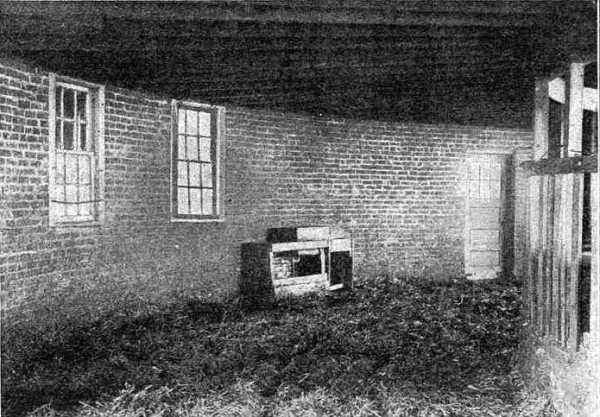 Fig. 10. Interior of cow stable, showing water trough with float
valve, salt box, and door into dairy.
Fig. 10. Interior of cow stable, showing water trough with float
valve, salt box, and door into dairy.
The table (page 12) is the final summing up of the cost of all the material for the completed dairy barns, with silos, and shows a saving of from 34 to 58 percent in favor of the round barn and silo, or an actual money saving in this case of from $379 to $1184, depending upon the size and construction of the barns.
Thoughtlessly, men go on building rectangular barns, but what would this reckless disregard of a possible saving of 34 to 58 percent mean in a year's business on the farm? Some illustrations may help us to understand what this money saved in building a round barn really amounts to, and its convenience is also a great saving. If the dairyman discarded the idea of a rectangular barn [Pg 15]and built a round barn instead, he could take the money thus saved and buy one of the best pure-bred sires for his herd, and also three to ten pure-bred heifers or fine grade cows. Either of these purchases might double the profit of the herd. Or, this saving, properly applied, would purchase many labor-saving devices which would make life less of a drudgery on many dairy farms. Is not such a saving worth while?
 Fig. 11. Cow comfort in a round barn.
Fig. 11. Cow comfort in a round barn.
When the comparative cost and merit of two constructions are known, it is a poor financier who will pay extra for the one which is inferior. If a man received bids from contractors for a building, he would be a foolish man who would accept one which is from 34 to 58 percent higher than the lowest bidder, especially when he knew the lowest bidder would put up the most convenient and substantial building.
[B] Since the deeper the silo the more firmly the silage packs, one silo 71 feet deep will hold as much as two silos of the same diameter and 44 feet deep.
The disadvantages of the round dairy barn are, that it cannot be enlarged by building on as readily as can the rectangular form, but as the round barn may be built higher to the eaves than a rectangular barn 36 feet wide, provision can be made for the growth of the herd by building so as to put cows in the second story and still leave sufficient mow room for hay.
[Pg 16]The objection is frequently raised that a round barn is difficult to light. This difficulty is entirely overcome in a barn 90 feet or less in diameter, if a sufficient number of properly spaced windows are used. See Figs. 4 and 30. With the same number of windows, the light is more evenly distributed in a round barn and the sun can shine directly into some portion at all hours of the day during the winter.
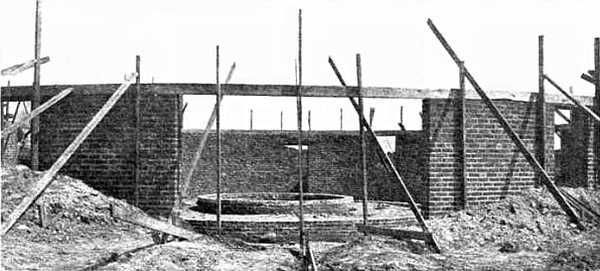 Fig. 12. First story wall, and foundation for silo, feed alley, and
manger; Sill in place, ready for joists and studs.
Fig. 12. First story wall, and foundation for silo, feed alley, and
manger; Sill in place, ready for joists and studs.
The objection has been raised that rectangular objects cannot be placed in a circle without a waste of space, but this does not apply to a dairy barn, as the storage of hay and grain depends upon cubical content, alone, and silos should always be circular, no matter where built. Cows, when lying down, are decidedly wedge-shaped, requiring much less space in front than behind. The objection may be raised, with round barns large enough for two rows of cows, that the row headed out does not use the space as economically as in the rectangular form, because a cow needs more width at the rear of the platform than at the manger. Where there are two rows of cows, the inner row is usually headed out, and as only about one-third of the cows are in this row, this loss of space is counterbalanced by the large number of cows in the outer circle using the space more economically than they do in the rectangular barn.
Box stalls cannot be as conveniently arranged, but in a one-row barn, gates hung on the outside and swung around to the manger, form stalls for cows at freshening time, and in a barn with two rows, box stalls can be arranged in the inner circle.
[Pg 17]
The barn is located on the side of a hill, sloping gently to the south and east. With this location, it was an advantage to excavate 5 feet deep on the northwest and run out to the surface of the ground on the southeast.
The footing for the foundation is 18 inches wide. A ten-inch brick wall was carried up nine feet above the stable floor. This wall contains a 2-inch air space to prevent moisture from condensing on the inner wall and making the barn damp. This is an important point, as barns with a solid stone or brick wall are very objectionable on account of dampness. It has been proven by two years' use that this difficulty is entirely obviated by the air space in the wall.
The foundation for the manger and feed alley is built up 2 feet above the stable floor. The foundation for the silo extends 4 feet below the stable floor and is continued 9 inches above the floor in the feed alley. This silo wall, together with the foundation under the manger, forms the foundation for the center supports of the barn. Fig. 12 shows the foundation completed.
[Pg 18]The silo, which is the Gurler type, was then started and carried up with the barn. It was built by placing 2 × 4 studs around the circle, one foot on centers, and ceiling inside with 1⁄2 × 6-inch lumber. This 1⁄2-inch lumber was obtained by re-sawing 1 × 6 yellow pine fencing. Common lath were then put on horizontally in the regular way inside, without furring out, and plastered with rich cement plaster.
The sill of the barn is 6 × 6, made up of 1 × 6s, and built on top of the wall. Building it up in this manner makes a stronger sill than can be obtained in any other way, as it forms a continuous hoop around the barn.
The joists are 2 × 12s notched 6 inches to fit the sill, so that the outer ends rest on both the sill and the brick wall. The outer span of joists is 14 feet and the inner ends of these joists rest on a similar sill built of 1 × 6s on top of the 4 × 4 supports at the stanchions. The inner span of joists, between the stanchions and the silo, is 8 feet, the outer end resting on the sill over the stanchions, and the inner end on a 11⁄2 × 6-inch band, made up[Pg 19] of three 1⁄2 × 6-inch pieces, running around the outside of the silo. These joists are placed 21⁄2 feet apart at the outside of the barn, and half as many joists are used in the inner span, making the joists at the silo one foot apart. The number of joists under the driveways are doubled, being only 1 foot and 3 inches apart at the outside of the barn.
The studs, which are 2 × 6s, 20 feet long, were then placed on the sill, about 2 feet 6 inches apart, being as evenly spaced between the windows as possible, and temporarily braced, as shown in Fig. 13, until the 8-inch ship lap ceiling could be nailed on the outside. This was carried up 5 feet to the second scaffold, and then covered to this height with shingles laid 5 inches to the weather. The scaffolding was then moved up and this process repeated until the siding was completed. The plate, made up of five 1 × 4s, was then built in the notch in the top of the studs shown in Fig. 13.
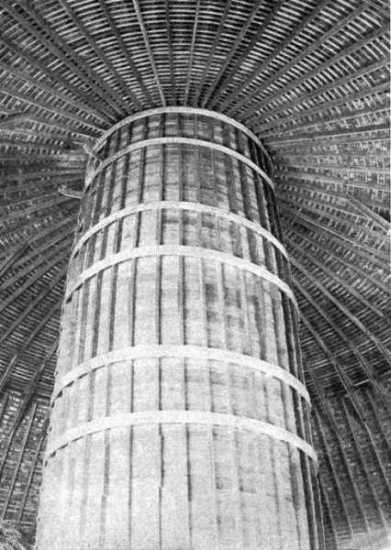 Fig. 16. Showing height of silo, capacity of barn, and construction
of roof.
Fig. 16. Showing height of silo, capacity of barn, and construction
of roof.
The silo was completed, as before described. The rafters,
which were framed on the ground, were then erected, as shown in
Fig. 14, the first eight going to the center of the roof, and the [Pg 20]
[Pg 21]remaining ones were cut to rest on the plate of the silo. There are
64 framed rafters, and these are the only ones in the upper section
of the roof. At the break in the roof, a header is cut in between
the framed rafters, and in the lower section a rafter is placed between
these, thus making twice as many rafters in the lower section
of the roof as in the upper section. After the rafters were all
in place and temporarily braced, the 1 × 2-inch sheathing was put
on, as shown in Fig. 15, and the shingles, which were the best 5⁄2
red cedar, were laid 5 inches to the weather on the lower section
of the roof, and 4 inches to the weather on the upper section, as
this had less pitch. No chalk line was necessary, as the shingles
were laid by the sheathing.
The floor was made of 1 × 8 ship lap, laid in four directions, as shown in Fig. 17. In the driveway an extra layer of ship lap was used, making this portion of the floor 2 inches thick.
[Pg 22]The doorways in the second story are 14 feet wide, and in the lower story 12 feet. These openings are closed by two sliding doors, each door being made of two sections, hinged together so as to follow the circular wall of the barn in opening.
The cow stable is on the ground floor, and well lighted by 16 windows having twelve 9 × 12 lights each. There are also six windows in the doors. The windows are placed just below the ceiling and admit an abundance of sunshine at all times of the day, which is one of the essentials of a good dairy barn.
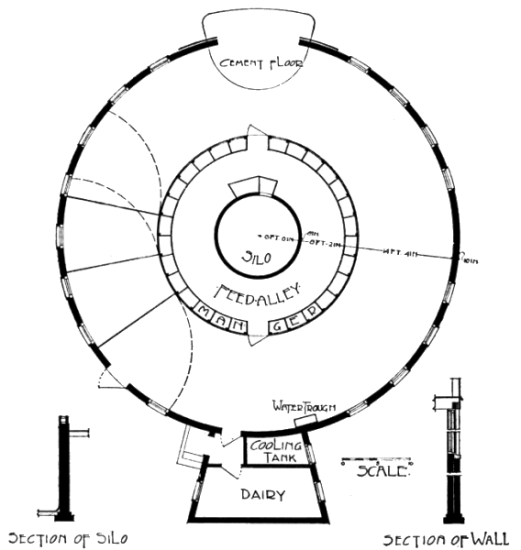 Fig. 18. Showing present arrangement of cow stable. There are
stanchions and mangers for 28 cows, and 2200 sq. ft. of floor space
in which the cows can run loose. The gates are swung into the
present position when box stalls are needed.
Fig. 18. Showing present arrangement of cow stable. There are
stanchions and mangers for 28 cows, and 2200 sq. ft. of floor space
in which the cows can run loose. The gates are swung into the
present position when box stalls are needed.
The floor, back of the manger, is of clay, except at the door,
where a small portion is covered with cement. The cows run loose [Pg 23]
[Pg 24]except at feeding and milking time, when they are placed in rigid
stanchions. It must be distinctly understood that rigid stanchions
are strongly condemned as a cow tie, where cows are to remain
in them all night, but as they are here used merely to hold the
cow during milking, they are both economical and convenient.
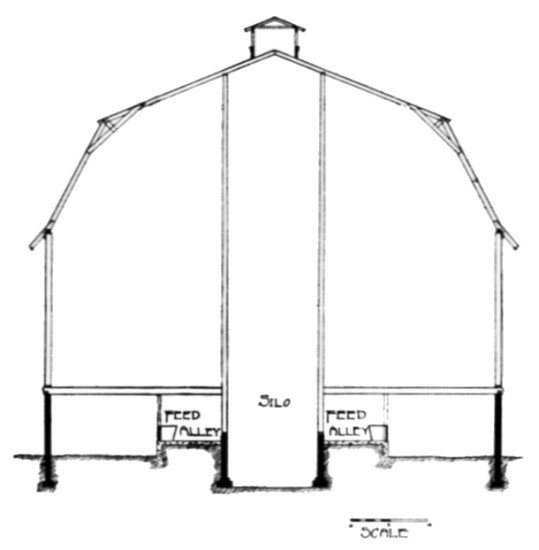 Fig. 19. Showing cross section of 60-foot round barn.
Fig. 19. Showing cross section of 60-foot round barn.
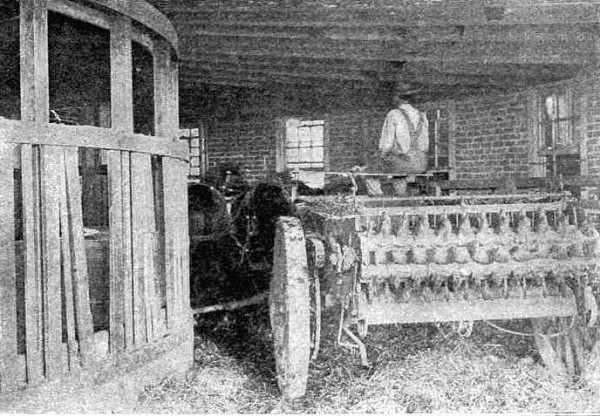 Fig. 20. Cleaning out cow stable with three-horse manure spreader.
Fig. 20. Cleaning out cow stable with three-horse manure spreader.
 Fig. 21. Cows in stanchion at milking time.
Fig. 21. Cows in stanchion at milking time.
Running cows loose in this manner is an excellent method, where bedding is abundant and sufficient space is available, as the cows are more comfortable, and all fertility is saved. There is no waste from leaching, as when the manure lies exposed to the weather. This method saves the labor of cleaning the stable, as the manure is loaded into the spreader and hauled directly upon the land whenever convenient, and the land is in the best condition to receive it.[C]
Three gates are hung on posts at the outside wall, and when box stalls are needed, these are swung around to the manger, as [Pg 25]shown in Fig. 18. The south door in the cow stable can be closed by slatted gates, thus affording an abundance of fresh air and sunshine on nice days, without letting the cows out of the barn.
[C] For a more detailed discussion of the advantages of keeping cows in this manner, see Illinois Agricultural Experiment Station Circular No. 93.
 Fig. 21. Continued.
Fig. 21. Continued.
The system of ventilation is the "King." To economize space and lumber, the hay chute is used for a ventilator. This chute, which extends to the cupola, is 21⁄4 × 31⁄2 feet, having a cross section area of 8 sq. ft., which, with a good draft, is sufficient for 40 cows. In order that this combination of ventilator and hay chute prove practical, doors thru which the hay could be thrust were placed at intervals in the side of the chute. These doors are hinged at the top, opening in, and close immediately after the hay drops, thus maintaining a closed ventilator chute. The air is drawn in at the bottom, the amount being regulated by means of a sliding door in the side. As this chute is 50 feet high, it creates a strong suction.
[Pg 26]
To economize space, the milk room, 12 × 16 feet, is located under the north driveway. The brick walls under the drive form the sides of this room, and the floor of the drive, which is made of 2 × 6s grooved on both edges, forms the roof. The grooves in the flooring were filled with white lead, and a wooden strip, fitted to fill the grooves of both planks, was driven in, forming a water-tight floor. This floor was covered with hot tar and sand 1⁄2 inch thick. The milk room is plastered on the inside, the plaster being applied directly to the brick walls, excepting in the case of the ceiling, which is lathed. The floor and cooling tank are of cement. The passage from the barn to the milk room is thru a small hallway, which is open to the outside, thus preventing the stable air getting into the milk room.
 Fig. 22. Feed alley, showing combined hay chute and ventilator.
A door on the side which is hinged at the bottom, 3 feet from
the floor, is let in toward the silo, sliding the hay onto the
floor. In hot weather this opening takes the heat out of the
barn; During the winter this door is kept closed and the ventilation
is regulated by raising the slide, as shown in the cut.
Fig. 22. Feed alley, showing combined hay chute and ventilator.
A door on the side which is hinged at the bottom, 3 feet from
the floor, is let in toward the silo, sliding the hay onto the
floor. In hot weather this opening takes the heat out of the
barn; During the winter this door is kept closed and the ventilation
is regulated by raising the slide, as shown in the cut.
This round dairy barn above described has been in use for over two years at the University of Illinois, and has given entire satisfaction.
[Pg 27]
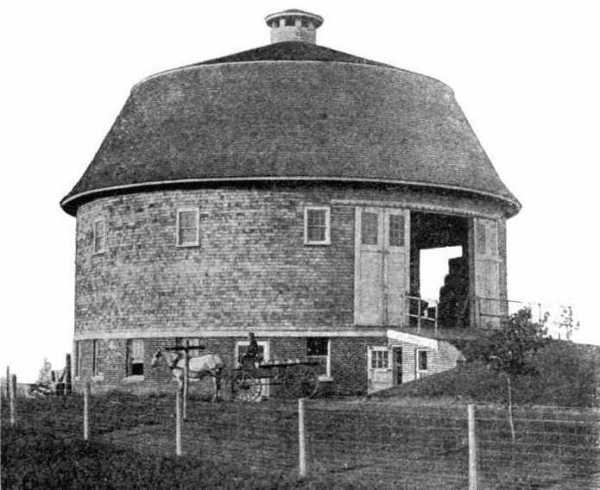 Fig. 23. Northeast view, showing dairy under driveway. The barn
is on the same scale as the drawing on page 28.
Fig. 23. Northeast view, showing dairy under driveway. The barn
is on the same scale as the drawing on page 28.
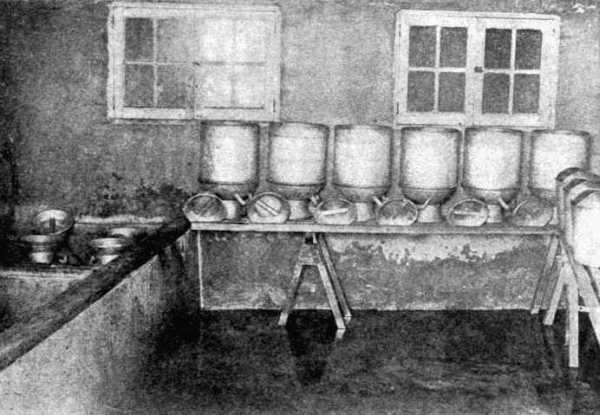 Fig. 24. Interior of dairy; Cooling tank on left.
Fig. 24. Interior of dairy; Cooling tank on left.
If it is desired to keep cows in stalls in a round barn of this size, the circular manger can be enlarged to 38 feet in diameter, which gives room for forty cows, as shown in Fig. 25, and the silo, to hold sufficient silage to feed the year round, enlarged to 18 feet in diameter. The present mow room is sufficient to store enough hay and bedding for this number of cows.
The barn on the Twenty-acre Demonstration Dairy Farm was built this large, as it was thought it might be desired at some future time to increase the size of the farm and herd, and the barn could easily be changed to accommodate a larger herd by simply enlarging the silo, without rebuilding the barn.
 Fig. 25. Showing how this 60-foot barn may be arranged to accommodate
40 cows in stalls. To supply this sized herd and the necessary
young stock with silage for eight months would require a 370-ton
silo, or one 18 feet in diameter and 56 feet deep; With a seven-foot
feed alley and a 21⁄2-foot manger, the circle at the stanchions
would be 38 feet in diameter, or 1191⁄3 feet in circumference;
Allowing 41⁄4 feet for two passage ways, the stalls would be 2 feet
10-1/2 inches wide at the stanchion, and 3 feet 6 inches at the drop.
Fig. 25. Showing how this 60-foot barn may be arranged to accommodate
40 cows in stalls. To supply this sized herd and the necessary
young stock with silage for eight months would require a 370-ton
silo, or one 18 feet in diameter and 56 feet deep; With a seven-foot
feed alley and a 21⁄2-foot manger, the circle at the stanchions
would be 38 feet in diameter, or 1191⁄3 feet in circumference;
Allowing 41⁄4 feet for two passage ways, the stalls would be 2 feet
10-1/2 inches wide at the stanchion, and 3 feet 6 inches at the drop.
[Pg 29]
| Excavating, foundation, and first story brick wall | $904.00 | |||||||||||||||||
| Lumber: | ||||||||||||||||||
| 149 | pieces, | 1 | × | 4 | × | 16 | Y. P. | |||||||||||
| 31 | „ | 1 | × | 4 | × | 14 | Cypress | |||||||||||
| 16 | „ | 1 | × | 4 | × | 12 | „ | |||||||||||
| 165 | „ | 1 | × | 6 | × | 16 | Y. P. | |||||||||||
| 17 | „ | 1 | × | 6 | × | 14 | „ | |||||||||||
| 226 | „ | 2 | × | 4 | × | 12 | „ | |||||||||||
| 20 | „ | 2 | × | 4 | × | 16 | „ | |||||||||||
| 6 | „ | 2 | × | 4 | × | 14 | „ | |||||||||||
| 15 | „ | 4 | × | 4 | × | 14 | „ | |||||||||||
| 120 | „ | 2 | × | 12 | × | 16 | „ | |||||||||||
| 23 | „ | 2 | × | 12 | × | 14 | „ | |||||||||||
| 100 | „ | 2 | × | 6 | × | 20 | „ | |||||||||||
| 144 | „ | 2 | × | 6 | × | 16 | „ | |||||||||||
| 67 | „ | 2 | × | 6 | × | 18 | „ | |||||||||||
| 4 | „ | 2 | × | 6 | × | 26 | „ | |||||||||||
| 60 | „ | 2 | × | 6 | × | 12 | „ | |||||||||||
| 30 | „ | 2 | × | 6 | × | 22 | „ | |||||||||||
| 4 | „ | 2 | × | 6 | × | 24 | „ | |||||||||||
| 6 | „ | 2 | × | 8 | × | 10 | „ | |||||||||||
| 9 | „ | 2 | × | 8 | × | 16 | „ | |||||||||||
| 4 | „ | 2 | × | 10 | × | 14 | „ | |||||||||||
| 11 | „ | 2 | × | 10 | × | 12 | „ | |||||||||||
| 1 | „ | 2 | × | 10 | × | 22 | „ | |||||||||||
| 1 | „ | 1 | × | 10 | × | 12 | „ | |||||||||||
| 1 | „ | 1 | × | 10 | × | 14 | Cypress | |||||||||||
| 2 | „ | 1 | × | 12 | × | 14 | „ | |||||||||||
| 22 | „ | 1 | 1⁄8 | × | 8 | × | 10 | Cyp. S2S | ||||||||||
| 2 | „ | 1 | × | 1 | 1⁄8 | × | 12 | × | 14 | „ | ||||||||
| 2 | „ | 1 | × | 1 | 1⁄8 | × | 12 | × | 16 | „ | ||||||||
| 6000 | feet of 8-inch ship lap | |||||||||||||||||
| 3150 | feet of 10-inch ship lap | |||||||||||||||||
| 71 | M 5⁄2 red cedar shingles | |||||||||||||||||
| 165 | Lineal feet of 2-inch Cr. molding | |||||||||||||||||
| 240 | Lineal feet of Cr. molding | |||||||||||||||||
| 270 | feet of 4-inch Y. P. S1S | |||||||||||||||||
| 4000 | feet of 6-inch rough pine | |||||||||||||||||
| 62 | feet of 3⁄8-inch Y. P. Ceiling | |||||||||||||||||
| 850 | feet of 6-inch No. 1 flooring | |||||||||||||||||
| 230 | feet of 6-inch fence flooring | |||||||||||||||||
| 56 | lineal feet of 1⁄2 × 3-inch battening | |||||||||||||||||
| 32 | lineal feet of lattice | |||||||||||||||||
| 444 | lineal feet of 4-inch cypress | |||||||||||||||||
| 3 | 10-foot cedar posts | |||||||||||||||||
| Total cost of lumber | $1,313.63 | |||||||||||||||||
| Mill work: | ||||||||||||||||||
| Window sash and doors | $270.00 | |||||||||||||||||
| Window and door frames | 71.00 | |||||||||||||||||
| Sawing lumber for silo, roof, bridge and stanchions | 29.78 | |||||||||||||||||
| Cost of hardware | 96.57 | |||||||||||||||||
| Carpenter work: | ||||||||||||||||||
| Head carpenter | 518 hrs. | @ | 40c | = | $207.20 | |||||||||||||
| Carpenters | 1057 hrs. | @ | 35c | = | 369.95 | |||||||||||||
| Common labor | 429 hrs. | @ | 20c | = | 85.80 | |||||||||||||
| Total cost for carpenter work | 662.95 | |||||||||||||||||
| Tiling around barn and silo, sewer from dairy room, retaining wall, cement floor in alley, dairy, doorway of barn, and steps and tanks | 128.54 | |||||||||||||||||
| Plastering dairy room and inside of silo | 104.60 | |||||||||||||||||
| Painting | 89.54 | |||||||||||||||||
| Total cost of barn | $3670.61 | |||||||||||||||||
 Fig. 26. Barn No. 2. 80 feet in diameter; Engine room in foreground.
Fig. 26. Barn No. 2. 80 feet in diameter; Engine room in foreground.
[Pg 30]The cost of this barn, if built on the ordinary dairy farm, could be materially reduced without shortening the life of the barn. Owing to the conditions under which this barn was built, it was necessary to pay for hauling all material to the farm, two and one-half miles from town. All of the labor had to be hired, and as it was necessary for the men to board themselves the wages paid were proportionately higher. The farmer usually does the excavating and hauls the brick, sand, and lumber with his own teams, tends the mason, and does quite an amount of the rough work with his own help, besides boarding the men, all of which would greatly reduce the cost. The construction could also be cheapened by using drop siding to cover the outside, instead of shingles, which in this case were used over ship lap on the side walls to improve the appearance. This barn could be still further cheapened by putting hoops, five feet apart, around the studs, and covering with common 1 × 12 boards, put on vertically, as is done in some cases. A saving could also be made on the mill work and large doors by[Pg 31] having the carpenters make these plainer and leave the windows out of them.
Anyone wishing to build a round barn can get local bids on the lumber bill, and determine approximately the cost in his locality. This will vary with both the location and the year.
Built 1897.
Diameter, 80 feet.
Capacity, 75 cows in 2 rows, tails together, 51 head in outer circle, 24 head in inner circle.
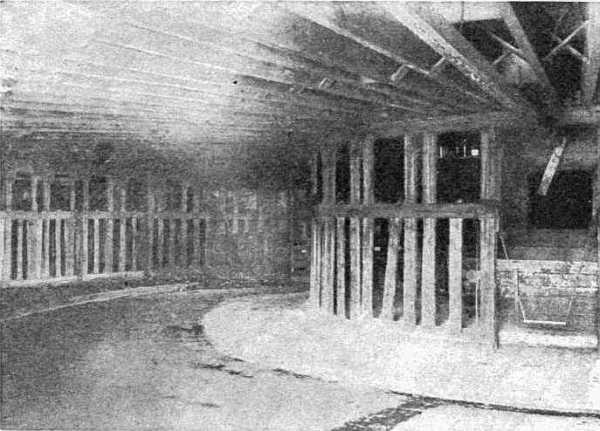 Fig. 27. Interior of Barn No. 2, showing two rows of stanchions and
drive behind cows which is used in cleaning barn; Silo on right.
Fig. 27. Interior of Barn No. 2, showing two rows of stanchions and
drive behind cows which is used in cleaning barn; Silo on right.
Cost, $1800.
Studs, 2 × 6s, placed 21⁄2 feet on center.
Supports, two 2 × 6s in each stanchion.
Joists, main span 3 × 12s, 20 feet long, placed 14 inches on center. Short spans over feed alleys, 2 × 10s.
Plate, 1 × 10-inch boards sprung around near top of studs.
[Pg 32]Roof supports, 6 × 6s placed 12 feet apart. Purline plate rests on these posts and consists of 1 × 8s sprung to the circle.
Siding, 8-inch, put on horizontally, first story ceiled inside.
To clean out, a wagon is driven around between the two rows of cows.
The chief objection to this barn is insufficient light in the cow stable.
This barn and No. 3 are approximately the same in construction, and are more substantially built than barns No. 4 and 5.
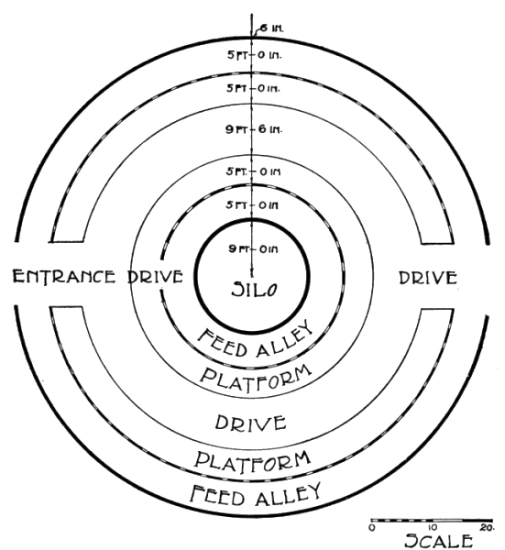 Fig. 28. Arrangement of cow stable in Barn No. 2; Two rows of
cows tailed together. The barn is cleaned by driving around
behind the cows.
Fig. 28. Arrangement of cow stable in Barn No. 2; Two rows of
cows tailed together. The barn is cleaned by driving around
behind the cows.
[Pg 33]
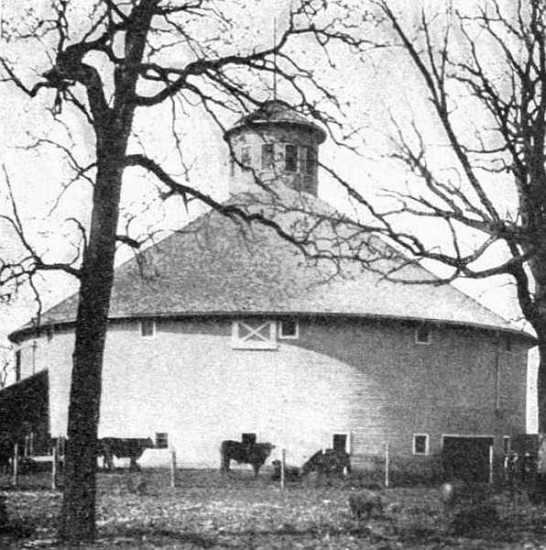 Fig. 29. Barn No. 3. 80 feet in diameter.
Fig. 29. Barn No. 3. 80 feet in diameter.
Built in 1900.
Diameter, 90 feet.
Capacity, 105 cows, two rows heading together.
Cost, $3000.
Foundation, width at base and top, 18 inches; depth in ground, 20 inches, (not sufficient).
Sills, 2 × 8s, sawed in short lengths, and placed flatwise.
Studding, 20-foot 2 × 8s, placed 3 feet on center and toenailed to sill.
Supports, first story 4 × 4s placed between stanchions in each row, making two rows of supports between the outside wall and the[Pg 34] silo; 4 × 4s cut to a circle placed on top of these supports. The outside span, over cows, is 13 feet 6 inches; middle span, over feed alley, 6 feet 8 inches, and inside span, over cows, 13 feet.
Joists, 2 × 8s placed 3 feet apart at studs on outside wall. There are as many joists in center of barn as at the outside.
Supports, second-story, consist of one row of posts running around at a point immediately under the break in the roof. These are 16 feet apart and are made of three 2 × 8s kept 2 inches apart by horizontal braces which run from studding near the eave thru these posts to studding in silo. See Fig. 31.
Plate, rafter is set on top of each stud, and no plate is used.
Rafters, 2 × 6s resting on studs at outside and on circular plate at break in roof.
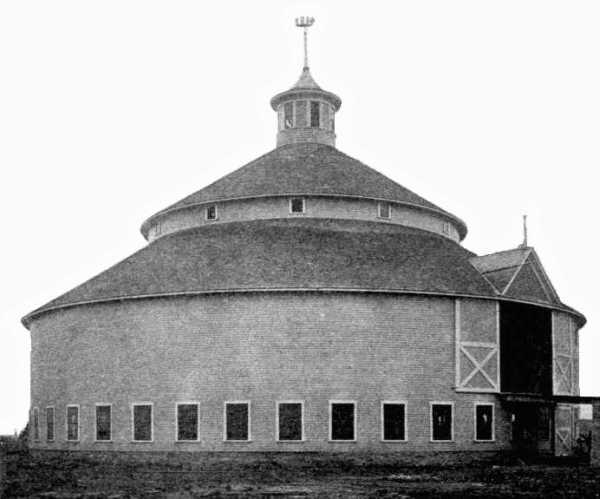 Fig. 30. Barn No. 4. 90 feet in diameter; One of the few dairy barns with
sufficient light; Same scale as drawing on page 37.
Fig. 30. Barn No. 4. 90 feet in diameter; One of the few dairy barns with
sufficient light; Same scale as drawing on page 37.
[Pg 35]
[Pg 36]Siding, 8-inch drop siding, put on horizontally, nailed with 10d nails. Ends holding well.
Windows, 12 light, 10 × 12 glass; one window every six feet. This gives an abundance of light in the center of the barn.
Doors, built on circle; (not satisfactory).
Silo, round; diameter, 24 feet over all; height, 53 feet, exclusive of 12-foot space for water tank on top; capacity, 500 tons. Studs of silo, 2 × 4s placed 12 inches on center. Ceiled inside of studs with two thicknesses of half-inch lumber with paper between.
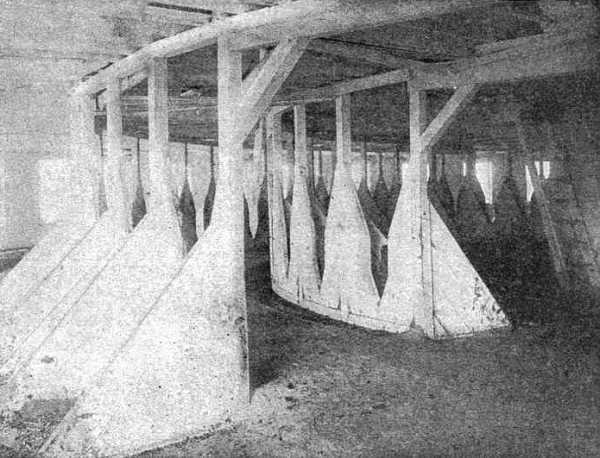 Fig. 32. Interior of Barn No. 4, showing stalls and feed alley.
Fig. 32. Interior of Barn No. 4, showing stalls and feed alley.
Remarks: Considering its size, the construction of this barn is apparently too light to be substantial, as the joists and studs are too small and too far apart, yet it has stood for nine years with no more evidence of wear than is common with any barn.
Were the owner to build again he would place the studs only 21⁄2 feet apart and use 2 × 12 joists, 21⁄2 feet apart at the outside wall. He would also use cement plaster on inside of silo.
[Pg 37]The owner says it would have cost him as much to have built a rectangular barn without the 500-ton silo, and containing 1300 sq. ft. less floor space. In other words, he gained a 500-ton silo and 1300 sq. ft. of floor space, besides an immense amount of mow room, by building a circular barn.
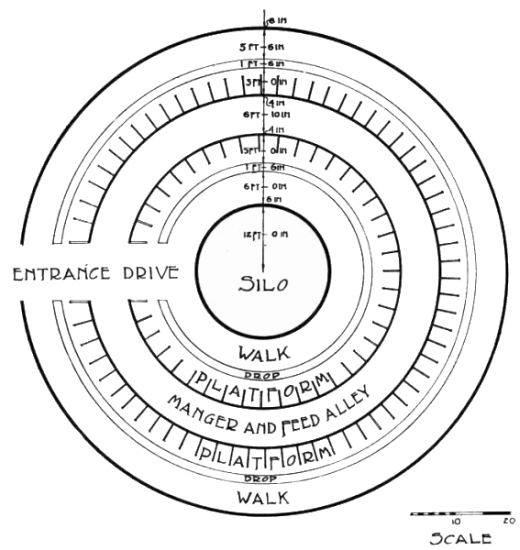 Fig. 33. Arrangement of cow stable in Barn No. 4, 90 feet in diameter;
Two rows of cows headed together.
Fig. 33. Arrangement of cow stable in Barn No. 4, 90 feet in diameter;
Two rows of cows headed together.
[Pg 38]
Built in 1906.
Diameter, 100 feet.
Capacity, 115 cows.
Cost, $3400.
Studding, 16-foot 2 × 6s, placed 3 feet on centers.
Supports, 3 rows 4 × 4s.
Joists, 2 × 10s, placed 3 feet on centers. Hemlock and yellow pine.
Floor, laid in eight directions.
Rafters, 2 × 6s spiked to studs. A band of two 1 × 6s is placed around the studs just below the rafters, and helps support the rafters.
Supports for roof. There are three purline plates. Two of these are supported by posts, the other by braces running out from the silo. The roof is straight from eaves to peak. The bracing is similar to that of barn No. 4.
Silo, 18 feet in diameter, 56 feet deep, 2 feet in ground. Capacity, 350 tons.
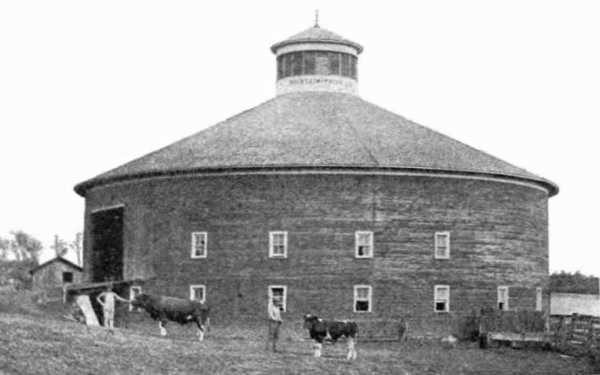 Fig. 34. Barn 92 feet in diameter; Two rows of cows headed
together; Silo in center.
Fig. 34. Barn 92 feet in diameter; Two rows of cows headed
together; Silo in center.
[Pg 39]
 Fig. 35. View of 70-foot self-supporting roof on barn shown in
fig. 36; Note hoops on studs in right foreground.
Fig. 35. View of 70-foot self-supporting roof on barn shown in
fig. 36; Note hoops on studs in right foreground.
[Pg 40]
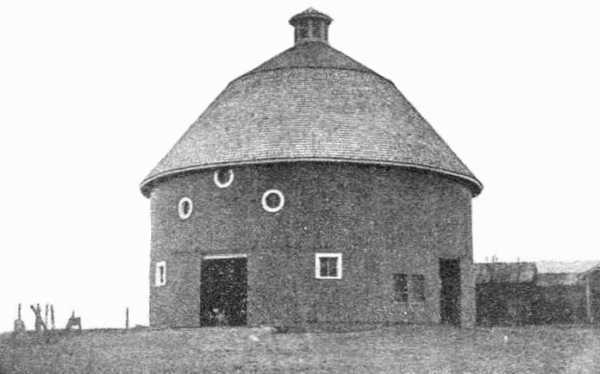 Fig. 37. Barn 40 feet in diameter.
Fig. 37. Barn 40 feet in diameter.
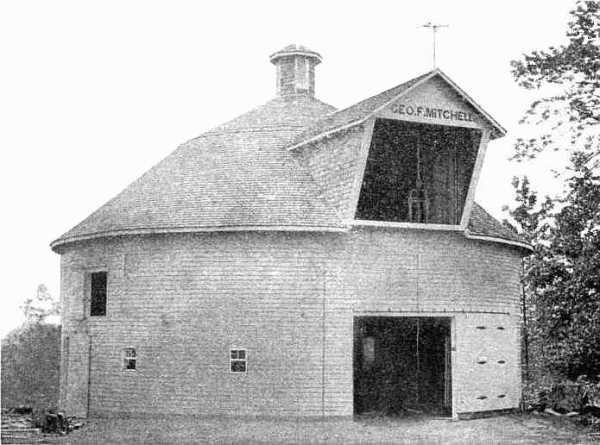 Fig. 38. Barn 48 feet in diameter, 16-foot posts; Note method of
taking hay into small round barn.
Fig. 38. Barn 48 feet in diameter, 16-foot posts; Note method of
taking hay into small round barn.
The round barns previously described do not meet the needs of the man with only a few cows. He usually wants a general-purpose barn. The circular form can be made satisfactory for this[Pg 41] purpose if proper attention is given to the plan. It is necessary that the cow stable be distinctly separated from all other stock by a tight wall. Round barns with this arrangement are giving satisfaction in Illinois at the present time.
 Fig. 39. Showing construction of barn in fig. 40. Hoops in place
ready for perpendicular siding; Roof sheathed for shingles.
Fig. 39. Showing construction of barn in fig. 40. Hoops in place
ready for perpendicular siding; Roof sheathed for shingles.
[Pg 42]
A polygonal barn has the disadvantages of both the rectangular and the round barn, and is less stable than either. It must necessarily have a heavy frame, which is expensive, and as the siding cannot run around the corners, it is very difficult to tie the different sides together sufficiently to prevent the barn being racked by the wind.
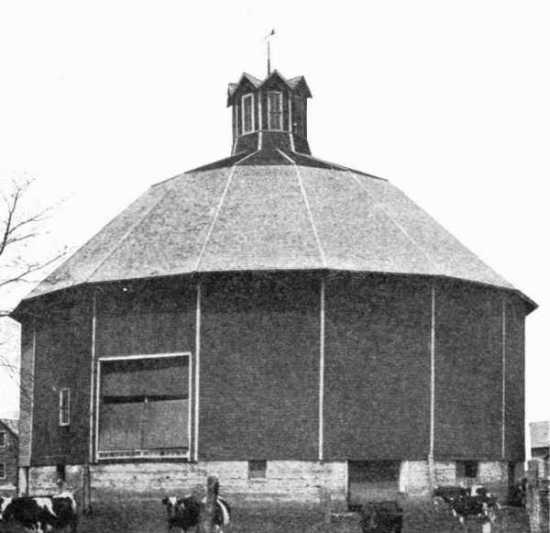 Fig. 41. Barn No. 6; 85 feet in diameter; Same scale as drawing on
opposite page.
Fig. 41. Barn No. 6; 85 feet in diameter; Same scale as drawing on
opposite page.
16-sided.
Built, 1888.
[Pg 43]Diameter, 85 feet.
Height, 26-foot posts on 9-foot wall.
Capacity, 88 cows; 350 tons of hay.
Foundation and first story, cement wall 9 feet above cement floor.
Supports, 4 × 8s, placed just back of stanchions, 3 feet on center.
Studs, 2 × 10s, 26 feet long, placed 21⁄2 feet on center.
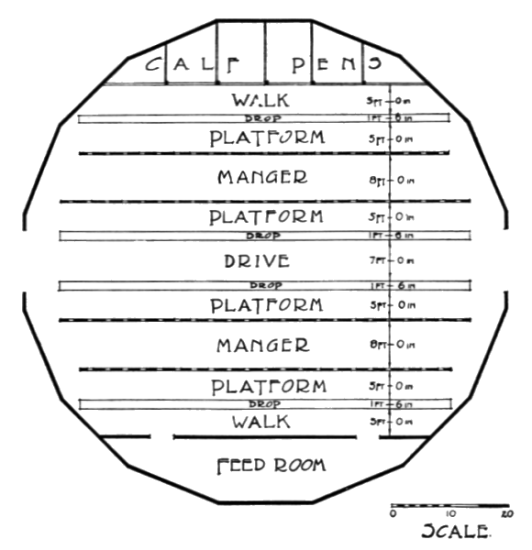 Fig. 42. Arrangement of cow stable in Barn No. 6.
Fig. 42. Arrangement of cow stable in Barn No. 6.
Joists 3 × 12s, 20 feet long, 14 inches on center for main span.
Rafters, self-supporting. Sheathed with 1 × 6s with no space between. This roof has a purline plate thrown in the gambrel. The plate is supported only by the braces which tie the joints.
The barn has been racked three times by the wind, replumbed and heavy iron rods put in to brace it, yet it is out of plumb at the present time.
[Pg 44]
In summing up the data given in this bulletin, it is obvious that the advantages of the round barn are convenience, strength, and cheapness.
The round barn is the more convenient, because of the unobstructed mow, which reduces the labor required in mowing hay, and because of the greater ease and fewer steps with which the feed can be gotten to the cows, owing to the central location of the supply.
The circular construction is the strongest because advantage is taken of the lineal strength of the lumber. All exposed surfaces are circular, and withstand greater wind pressure, as the wind can get no direct hold, as on the sides or gable ends of a rectangular barn.
In round numbers, rectangular barns require, according to their construction, from 34 to 58 percent more in cost of material than round barns with the same floor area and built of the same grade of material.
TRANSCRIBER NOTES:
Punctuation has been normalized without note.
Scale references in photos have not been retained.
Footnotes have been moved to the end of each section.
Hyphenation of words has been changed to be more consistent throughout the text.
Some page numbers are missing due to movement of tables from their original location.
Page 6: "betwen" changed to "between" (midway between the silo and the outside wall).
End of the Project Gutenberg EBook of Economy of the Round Dairy Barn, by
Wilber John Fraser
*** END OF THIS PROJECT GUTENBERG EBOOK ECONOMY OF THE ROUND DAIRY BARN ***
***** This file should be named 38321-h.htm or 38321-h.zip *****
This and all associated files of various formats will be found in:
http://www.gutenberg.org/3/8/3/2/38321/
Produced by Bryan Ness, Pat McCoy and the Online Distributed
Proofreading Team at http://www.pgdp.net (This file was
produced from images generously made available by The
Internet Archive/American Libraries.)
Updated editions will replace the previous one--the old editions
will be renamed.
Creating the works from public domain print editions means that no
one owns a United States copyright in these works, so the Foundation
(and you!) can copy and distribute it in the United States without
permission and without paying copyright royalties. Special rules,
set forth in the General Terms of Use part of this license, apply to
copying and distributing Project Gutenberg-tm electronic works to
protect the PROJECT GUTENBERG-tm concept and trademark. Project
Gutenberg is a registered trademark, and may not be used if you
charge for the eBooks, unless you receive specific permission. If you
do not charge anything for copies of this eBook, complying with the
rules is very easy. You may use this eBook for nearly any purpose
such as creation of derivative works, reports, performances and
research. They may be modified and printed and given away--you may do
practically ANYTHING with public domain eBooks. Redistribution is
subject to the trademark license, especially commercial
redistribution.
*** START: FULL LICENSE ***
THE FULL PROJECT GUTENBERG LICENSE
PLEASE READ THIS BEFORE YOU DISTRIBUTE OR USE THIS WORK
To protect the Project Gutenberg-tm mission of promoting the free
distribution of electronic works, by using or distributing this work
(or any other work associated in any way with the phrase "Project
Gutenberg"), you agree to comply with all the terms of the Full Project
Gutenberg-tm License (available with this file or online at
http://gutenberg.org/license).
Section 1. General Terms of Use and Redistributing Project Gutenberg-tm
electronic works
1.A. By reading or using any part of this Project Gutenberg-tm
electronic work, you indicate that you have read, understand, agree to
and accept all the terms of this license and intellectual property
(trademark/copyright) agreement. If you do not agree to abide by all
the terms of this agreement, you must cease using and return or destroy
all copies of Project Gutenberg-tm electronic works in your possession.
If you paid a fee for obtaining a copy of or access to a Project
Gutenberg-tm electronic work and you do not agree to be bound by the
terms of this agreement, you may obtain a refund from the person or
entity to whom you paid the fee as set forth in paragraph 1.E.8.
1.B. "Project Gutenberg" is a registered trademark. It may only be
used on or associated in any way with an electronic work by people who
agree to be bound by the terms of this agreement. There are a few
things that you can do with most Project Gutenberg-tm electronic works
even without complying with the full terms of this agreement. See
paragraph 1.C below. There are a lot of things you can do with Project
Gutenberg-tm electronic works if you follow the terms of this agreement
and help preserve free future access to Project Gutenberg-tm electronic
works. See paragraph 1.E below.
1.C. The Project Gutenberg Literary Archive Foundation ("the Foundation"
or PGLAF), owns a compilation copyright in the collection of Project
Gutenberg-tm electronic works. Nearly all the individual works in the
collection are in the public domain in the United States. If an
individual work is in the public domain in the United States and you are
located in the United States, we do not claim a right to prevent you from
copying, distributing, performing, displaying or creating derivative
works based on the work as long as all references to Project Gutenberg
are removed. Of course, we hope that you will support the Project
Gutenberg-tm mission of promoting free access to electronic works by
freely sharing Project Gutenberg-tm works in compliance with the terms of
this agreement for keeping the Project Gutenberg-tm name associated with
the work. You can easily comply with the terms of this agreement by
keeping this work in the same format with its attached full Project
Gutenberg-tm License when you share it without charge with others.
1.D. The copyright laws of the place where you are located also govern
what you can do with this work. Copyright laws in most countries are in
a constant state of change. If you are outside the United States, check
the laws of your country in addition to the terms of this agreement
before downloading, copying, displaying, performing, distributing or
creating derivative works based on this work or any other Project
Gutenberg-tm work. The Foundation makes no representations concerning
the copyright status of any work in any country outside the United
States.
1.E. Unless you have removed all references to Project Gutenberg:
1.E.1. The following sentence, with active links to, or other immediate
access to, the full Project Gutenberg-tm License must appear prominently
whenever any copy of a Project Gutenberg-tm work (any work on which the
phrase "Project Gutenberg" appears, or with which the phrase "Project
Gutenberg" is associated) is accessed, displayed, performed, viewed,
copied or distributed:
This eBook is for the use of anyone anywhere at no cost and with
almost no restrictions whatsoever. You may copy it, give it away or
re-use it under the terms of the Project Gutenberg License included
with this eBook or online at www.gutenberg.org
1.E.2. If an individual Project Gutenberg-tm electronic work is derived
from the public domain (does not contain a notice indicating that it is
posted with permission of the copyright holder), the work can be copied
and distributed to anyone in the United States without paying any fees
or charges. If you are redistributing or providing access to a work
with the phrase "Project Gutenberg" associated with or appearing on the
work, you must comply either with the requirements of paragraphs 1.E.1
through 1.E.7 or obtain permission for the use of the work and the
Project Gutenberg-tm trademark as set forth in paragraphs 1.E.8 or
1.E.9.
1.E.3. If an individual Project Gutenberg-tm electronic work is posted
with the permission of the copyright holder, your use and distribution
must comply with both paragraphs 1.E.1 through 1.E.7 and any additional
terms imposed by the copyright holder. Additional terms will be linked
to the Project Gutenberg-tm License for all works posted with the
permission of the copyright holder found at the beginning of this work.
1.E.4. Do not unlink or detach or remove the full Project Gutenberg-tm
License terms from this work, or any files containing a part of this
work or any other work associated with Project Gutenberg-tm.
1.E.5. Do not copy, display, perform, distribute or redistribute this
electronic work, or any part of this electronic work, without
prominently displaying the sentence set forth in paragraph 1.E.1 with
active links or immediate access to the full terms of the Project
Gutenberg-tm License.
1.E.6. You may convert to and distribute this work in any binary,
compressed, marked up, nonproprietary or proprietary form, including any
word processing or hypertext form. However, if you provide access to or
distribute copies of a Project Gutenberg-tm work in a format other than
"Plain Vanilla ASCII" or other format used in the official version
posted on the official Project Gutenberg-tm web site (www.gutenberg.org),
you must, at no additional cost, fee or expense to the user, provide a
copy, a means of exporting a copy, or a means of obtaining a copy upon
request, of the work in its original "Plain Vanilla ASCII" or other
form. Any alternate format must include the full Project Gutenberg-tm
License as specified in paragraph 1.E.1.
1.E.7. Do not charge a fee for access to, viewing, displaying,
performing, copying or distributing any Project Gutenberg-tm works
unless you comply with paragraph 1.E.8 or 1.E.9.
1.E.8. You may charge a reasonable fee for copies of or providing
access to or distributing Project Gutenberg-tm electronic works provided
that
- You pay a royalty fee of 20% of the gross profits you derive from
the use of Project Gutenberg-tm works calculated using the method
you already use to calculate your applicable taxes. The fee is
owed to the owner of the Project Gutenberg-tm trademark, but he
has agreed to donate royalties under this paragraph to the
Project Gutenberg Literary Archive Foundation. Royalty payments
must be paid within 60 days following each date on which you
prepare (or are legally required to prepare) your periodic tax
returns. Royalty payments should be clearly marked as such and
sent to the Project Gutenberg Literary Archive Foundation at the
address specified in Section 4, "Information about donations to
the Project Gutenberg Literary Archive Foundation."
- You provide a full refund of any money paid by a user who notifies
you in writing (or by e-mail) within 30 days of receipt that s/he
does not agree to the terms of the full Project Gutenberg-tm
License. You must require such a user to return or
destroy all copies of the works possessed in a physical medium
and discontinue all use of and all access to other copies of
Project Gutenberg-tm works.
- You provide, in accordance with paragraph 1.F.3, a full refund of any
money paid for a work or a replacement copy, if a defect in the
electronic work is discovered and reported to you within 90 days
of receipt of the work.
- You comply with all other terms of this agreement for free
distribution of Project Gutenberg-tm works.
1.E.9. If you wish to charge a fee or distribute a Project Gutenberg-tm
electronic work or group of works on different terms than are set
forth in this agreement, you must obtain permission in writing from
both the Project Gutenberg Literary Archive Foundation and Michael
Hart, the owner of the Project Gutenberg-tm trademark. Contact the
Foundation as set forth in Section 3 below.
1.F.
1.F.1. Project Gutenberg volunteers and employees expend considerable
effort to identify, do copyright research on, transcribe and proofread
public domain works in creating the Project Gutenberg-tm
collection. Despite these efforts, Project Gutenberg-tm electronic
works, and the medium on which they may be stored, may contain
"Defects," such as, but not limited to, incomplete, inaccurate or
corrupt data, transcription errors, a copyright or other intellectual
property infringement, a defective or damaged disk or other medium, a
computer virus, or computer codes that damage or cannot be read by
your equipment.
1.F.2. LIMITED WARRANTY, DISCLAIMER OF DAMAGES - Except for the "Right
of Replacement or Refund" described in paragraph 1.F.3, the Project
Gutenberg Literary Archive Foundation, the owner of the Project
Gutenberg-tm trademark, and any other party distributing a Project
Gutenberg-tm electronic work under this agreement, disclaim all
liability to you for damages, costs and expenses, including legal
fees. YOU AGREE THAT YOU HAVE NO REMEDIES FOR NEGLIGENCE, STRICT
LIABILITY, BREACH OF WARRANTY OR BREACH OF CONTRACT EXCEPT THOSE
PROVIDED IN PARAGRAPH 1.F.3. YOU AGREE THAT THE FOUNDATION, THE
TRADEMARK OWNER, AND ANY DISTRIBUTOR UNDER THIS AGREEMENT WILL NOT BE
LIABLE TO YOU FOR ACTUAL, DIRECT, INDIRECT, CONSEQUENTIAL, PUNITIVE OR
INCIDENTAL DAMAGES EVEN IF YOU GIVE NOTICE OF THE POSSIBILITY OF SUCH
DAMAGE.
1.F.3. LIMITED RIGHT OF REPLACEMENT OR REFUND - If you discover a
defect in this electronic work within 90 days of receiving it, you can
receive a refund of the money (if any) you paid for it by sending a
written explanation to the person you received the work from. If you
received the work on a physical medium, you must return the medium with
your written explanation. The person or entity that provided you with
the defective work may elect to provide a replacement copy in lieu of a
refund. If you received the work electronically, the person or entity
providing it to you may choose to give you a second opportunity to
receive the work electronically in lieu of a refund. If the second copy
is also defective, you may demand a refund in writing without further
opportunities to fix the problem.
1.F.4. Except for the limited right of replacement or refund set forth
in paragraph 1.F.3, this work is provided to you 'AS-IS' WITH NO OTHER
WARRANTIES OF ANY KIND, EXPRESS OR IMPLIED, INCLUDING BUT NOT LIMITED TO
WARRANTIES OF MERCHANTIBILITY OR FITNESS FOR ANY PURPOSE.
1.F.5. Some states do not allow disclaimers of certain implied
warranties or the exclusion or limitation of certain types of damages.
If any disclaimer or limitation set forth in this agreement violates the
law of the state applicable to this agreement, the agreement shall be
interpreted to make the maximum disclaimer or limitation permitted by
the applicable state law. The invalidity or unenforceability of any
provision of this agreement shall not void the remaining provisions.
1.F.6. INDEMNITY - You agree to indemnify and hold the Foundation, the
trademark owner, any agent or employee of the Foundation, anyone
providing copies of Project Gutenberg-tm electronic works in accordance
with this agreement, and any volunteers associated with the production,
promotion and distribution of Project Gutenberg-tm electronic works,
harmless from all liability, costs and expenses, including legal fees,
that arise directly or indirectly from any of the following which you do
or cause to occur: (a) distribution of this or any Project Gutenberg-tm
work, (b) alteration, modification, or additions or deletions to any
Project Gutenberg-tm work, and (c) any Defect you cause.
Section 2. Information about the Mission of Project Gutenberg-tm
Project Gutenberg-tm is synonymous with the free distribution of
electronic works in formats readable by the widest variety of computers
including obsolete, old, middle-aged and new computers. It exists
because of the efforts of hundreds of volunteers and donations from
people in all walks of life.
Volunteers and financial support to provide volunteers with the
assistance they need, are critical to reaching Project Gutenberg-tm's
goals and ensuring that the Project Gutenberg-tm collection will
remain freely available for generations to come. In 2001, the Project
Gutenberg Literary Archive Foundation was created to provide a secure
and permanent future for Project Gutenberg-tm and future generations.
To learn more about the Project Gutenberg Literary Archive Foundation
and how your efforts and donations can help, see Sections 3 and 4
and the Foundation web page at http://www.pglaf.org.
Section 3. Information about the Project Gutenberg Literary Archive
Foundation
The Project Gutenberg Literary Archive Foundation is a non profit
501(c)(3) educational corporation organized under the laws of the
state of Mississippi and granted tax exempt status by the Internal
Revenue Service. The Foundation's EIN or federal tax identification
number is 64-6221541. Its 501(c)(3) letter is posted at
http://pglaf.org/fundraising. Contributions to the Project Gutenberg
Literary Archive Foundation are tax deductible to the full extent
permitted by U.S. federal laws and your state's laws.
The Foundation's principal office is located at 4557 Melan Dr. S.
Fairbanks, AK, 99712., but its volunteers and employees are scattered
throughout numerous locations. Its business office is located at
809 North 1500 West, Salt Lake City, UT 84116, (801) 596-1887, email
business@pglaf.org. Email contact links and up to date contact
information can be found at the Foundation's web site and official
page at http://pglaf.org
For additional contact information:
Dr. Gregory B. Newby
Chief Executive and Director
gbnewby@pglaf.org
Section 4. Information about Donations to the Project Gutenberg
Literary Archive Foundation
Project Gutenberg-tm depends upon and cannot survive without wide
spread public support and donations to carry out its mission of
increasing the number of public domain and licensed works that can be
freely distributed in machine readable form accessible by the widest
array of equipment including outdated equipment. Many small donations
($1 to $5,000) are particularly important to maintaining tax exempt
status with the IRS.
The Foundation is committed to complying with the laws regulating
charities and charitable donations in all 50 states of the United
States. Compliance requirements are not uniform and it takes a
considerable effort, much paperwork and many fees to meet and keep up
with these requirements. We do not solicit donations in locations
where we have not received written confirmation of compliance. To
SEND DONATIONS or determine the status of compliance for any
particular state visit http://pglaf.org
While we cannot and do not solicit contributions from states where we
have not met the solicitation requirements, we know of no prohibition
against accepting unsolicited donations from donors in such states who
approach us with offers to donate.
International donations are gratefully accepted, but we cannot make
any statements concerning tax treatment of donations received from
outside the United States. U.S. laws alone swamp our small staff.
Please check the Project Gutenberg Web pages for current donation
methods and addresses. Donations are accepted in a number of other
ways including checks, online payments and credit card donations.
To donate, please visit: http://pglaf.org/donate
Section 5. General Information About Project Gutenberg-tm electronic
works.
Professor Michael S. Hart is the originator of the Project Gutenberg-tm
concept of a library of electronic works that could be freely shared
with anyone. For thirty years, he produced and distributed Project
Gutenberg-tm eBooks with only a loose network of volunteer support.
Project Gutenberg-tm eBooks are often created from several printed
editions, all of which are confirmed as Public Domain in the U.S.
unless a copyright notice is included. Thus, we do not necessarily
keep eBooks in compliance with any particular paper edition.
Most people start at our Web site which has the main PG search facility:
http://www.gutenberg.org
This Web site includes information about Project Gutenberg-tm,
including how to make donations to the Project Gutenberg Literary
Archive Foundation, how to help produce our new eBooks, and how to
subscribe to our email newsletter to hear about new eBooks.